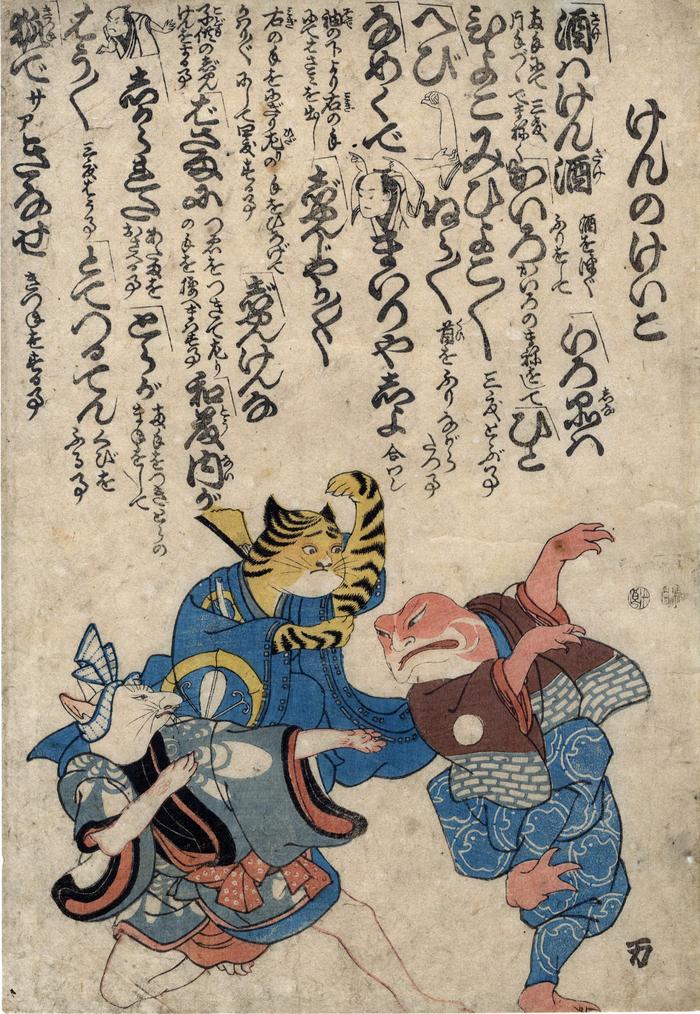Utagawa Kuniyoshi (歌川国芳) (artist 11/15/1797 – 03/05/1861)
Ken Practice (Ken no keiko - けんのけいこ) from the play Norikake Soga dōchū sugoroku (飾駒曽我通双六)
1847
9.75 in x 14.25 in (Overall dimensions) Japanese woodblock print
Artist: Unsigned but probably Kuniyoshi
Publisher: Man (Marks U179 - seal 15-140)
Censor seals - Mera and Murata
Shizuoka Prefectural Central Library
Victoria and Albert Museum This print is unsigned. The frog, fox, and tiger are believed to represent the kabuki actors Nakamura Utaemon IV, Matsumoto Kōshirō VI, and Ichikawa Kuzō II.
Prints depicting the game of ken are called ken no e. Ken was often played as a drinking game and was incorporated into several kabuki plays as a dance. After the imposition of a ban on actor prints in 1842, Kuniyoshi produced numerous humorous designs with thinly disguised actors’ portraits as animals or other creatures playing ken.
****
"At the beginning of the 4th year of the Kōka era (7847), a very curious print appeared in Edo: three strange animals dressed like human beings dance and jump while performing strange gestures with their hands... On closer examination, one of the animals seems to be a fox with a pointed nose, one a tiger with saucer eyes, and the third a frog with protruding lips. Written on the upper part of the print is:
Sake wa ken-zake
iroshina wa
kairu hitohyoko mihyokohyoko
hebi nura nura
nameku de mabimasho
[sore] janjaka janjaka jan-ken na
basama ni
Watōnai ga shikarareta
tora wa hōhō
totetsuruten
kitsune de sā kinasē
Sake has to be ken-zake,
but there are different kinds:
The frog jumps one time,
three times.
The serpent trail's slippery[?].
Let us take the snail!
Ding-Dong, Ding-Dong -
stone-ken!
By his old mother Watōnai was scolded.
The tiger whoops,
accompanied by a shamisen.
Come with the fox!
This odd print is not signed, and the publisher's logo consists of the Chinese character for 'ten thousand', man, yorozu, which has not yet been identified. However, we do know to which play this print refers, namely to the comic dance interlude (shosagoto) Wararau kado niwakn no shichifuku (Sevenfold luck through the Niwaka dance at the door of those laughing) which was given as part of the New Year's performance of Norikake Soga dōchū sugoroku (About to begin a Soga travel sugoroku game) at the Kawarasaki-za in Edo in 1847.
This anonymous print is usually ascribed to Kuniyoshi, because he made several other pictures with the same animals, and we know from earlier Kuniyoshi pictures that he liked to depict actors disguised as animals: cats, goldfish" turtles and others, thus breaking the rule that from 1842 onwards no actor's face should be drawn on a níshiki-e...
Although a number of prints were issued on the occasion of every new performance by the big Kabuki theatres in Edo, the sheer number of prints issued for the Wararau kado niwakn no shichifuku tells us that this play must have been especially popular among Edo's citizens, and several contemporary sources confirm this impression. The text is about a conversation between a bathhouse servant, a so-called osso, and two other men. The lowly osso tells them that he wants to become an entertainer, taikomochi, whereupon the two tell him that in order to become a taikomochi he has to master a certain artistry, a gei, and ask whether he is mastering it. The osso replies that he knows ken, at which the others laugh, saying there is no artistry in ken.To give proof to the contrary the osso starts to sing and dance to the song he has mentioned, and the two others quickly join in."
Source and quotes from 'Kuniyoshi’s Ken Caricatures between 1847 and 1853', Sepp Linhart, Andon, Vol. 83, 2008, pp. 6-7.
Later Linhart wrote: "The three actors who performed the Totetsuru-ken on the stage had such individual characteristics that they were frequently drawn as the three animals appearing in the ken games. Nakamura Utaemon IV, who is always represented as a frog, had especially thick protruding lips, Matsumoto Kōshirō VI, the fox, was well known for his long nose, and Ichikawa Kuzō II, drawn as tiger, had pronounced 'saucer' eyes." (Ibid., p. 8)
****
This print, all in red, was used as the cover of one of the editions of Japan at Play: The Ludic and Logic of Power edited by Joy Hendry and Massimo Raveri.
****
Illustrated in:
1) Ken no bunkashi / Seppu Rinharuto (拳の文化史 / セップ・リンハルト) by Sepp Linhart, 1998, p. 54.
2) color in Kuniyoshi’s Ken Caricatures between 1847 and 1853', Sepp Linhart, Andon, Vol. 83, 2008, p. 6, fig. 1.
comic prints (giga - 戯画 / kyōga - 狂画) (genre)
ken (拳) (genre)
Man (publisher)
Nakamura Utaemon IV (四代目中村歌右衛門: 1/1836-2/1852) (actor)
Matsumoto Kōshirō V (五代目松本幸四郎: 11/1801 to 5/1838) (actor)
Ichikawa Kuzō II (二代目市川九蔵: from 11/1835 to 9/1852) (actor)
